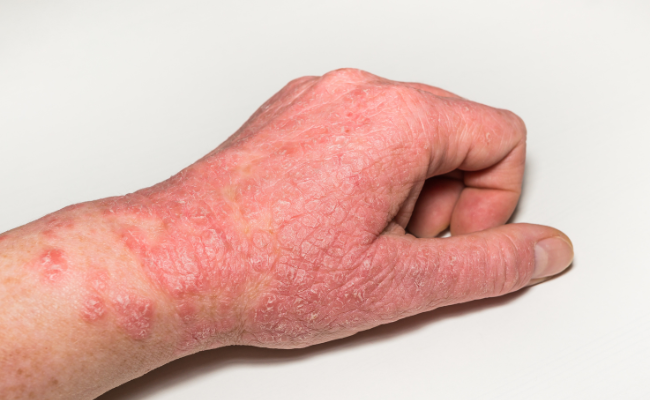How to Treat Pompholyx?
- January 06, 2024
- No Comments

What is Pompholyx?
Pompholyx, also referred to as dyshidrotic eczema or vesicular eczema, is a chronic skin condition characterized by the formation of small, itchy blisters on the hands and feet. These blisters are commonly filled with clear fluid and may be accompanied by redness, inflammation, and peeling of the skin. Pompholyx predominantly affects the palms, sides of the fingers, and soles of the feet. The exact cause of pompholyx is not fully understood, but it is believed to result from a combination of genetic and environmental factors.
Why Does Pompholyx Occur?
Understanding why pompholyx occurs involves considering various contributing factors:
- Genetics: Individuals with a family history of eczema or atopic dermatitis may have a genetic predisposition to developing pompholyx. Genetic factors play a role in the susceptibility to skin conditions, and the presence of certain genes may increase the likelihood of experiencing pompholyx.
- Environmental Triggers: Pompholyx flare-ups are often associated with exposure to specific environmental triggers. These triggers can include allergens, irritants, or stressful situations. Identifying and minimizing exposure to these triggers is crucial in managing and preventing pompholyx episodes.
- Dysfunction of Sweat Glands: Some theories suggest that dysfunction of the sweat glands in the hands and feet may contribute to the development of pompholyx. Sweat gland abnormalities can impact the regulation of moisture in the skin, leading to the formation of blisters.
- Immune System Response: An abnormal immune system response is thought to be involved in the inflammatory process that leads to blister formation in pompholyx. The immune system may react excessively to certain triggers, initiating the cascade of symptoms associated with the condition.
How Does Pompholyx Manifest?
Pompholyx typically presents with the distinctive appearance of small blisters, often grouped together on the hands and/or feet. These blisters are intensely itchy and can cause significant discomfort. In more severe cases, the blisters may become larger, and the surrounding skin may exhibit redness and swelling. As the blisters progress, they may rupture, leading to the formation of crusts and scales. Over time, recurrent episodes of pompholyx can result in chronic changes in the skin, including thickening and fissuring of the affected areas.
Treatment Solutions for Pompholyx
While there is no cure for pompholyx, several treatment options are available to manage symptoms, reduce inflammation, and prevent flare-ups. The approach to treatment is often individualized based on the severity of the condition and the specific needs of the patient.
- Topical Steroids: Mild to moderate cases of pompholyx are commonly treated with topical steroids. These medications help to reduce inflammation and alleviate itching. Depending on the severity, stronger steroids may be prescribed for more acute flare-ups.
- Topical Calcineurin Inhibitors: Calcineurin inhibitors, such as tacrolimus and pimecrolimus, are topical medications that work by suppressing the immune response in the skin. This helps in reducing inflammation and preventing the formation of blisters.
- Emollients and Moisturizers: Regular use of emollients and moisturizers is essential in managing pompholyx. These products help keep the skin hydrated, reducing dryness and preventing flare-ups. Thick ointments or creams are often recommended for this purpose.
- Cool Compresses: Applying cool compresses to the affected areas can provide relief from itching and reduce inflammation. Avoiding exposure to hot water and excessive heat is crucial to prevent worsening of symptoms.
- Avoiding Triggers: Identifying and avoiding potential triggers is a key component of managing pompholyx. This may involve lifestyle modifications, such as avoiding specific allergens, irritants, or stressors that contribute to flare-ups.
- Oral Steroids: In cases of severe flare-ups or acute episodes, oral steroids may be prescribed for a short duration to rapidly reduce inflammation and alleviate symptoms. However, long-term use of oral steroids is generally avoided due to potential side effects.
Benefit Points of Pompholyx Treatment
- Symptom Relief: Treatment aims to provide relief from the intense itching, pain, and discomfort associated with pompholyx. This leads to an overall improvement in the quality of life for individuals experiencing these symptoms.
- Prevention of Flare-ups: Consistent use of prescribed medications and adherence to preventive measures can significantly reduce the frequency and severity of pompholyx flare-ups. This proactive approach helps in preventing the recurrence of blisters and other symptoms.
- Improved Skin Health: Regular use of emollients and moisturizers contributes to improved skin health. Well-hydrated skin is less prone to dryness and is more resilient against factors that may trigger pompholyx.
- Enhanced Comfort: Cooling measures, such as cool compresses and avoiding excessive heat, contribute to enhanced comfort for individuals experiencing pompholyx symptoms. These measures help soothe the skin and alleviate inflammation.
- Management of Chronic Changes: Long-term management of pompholyx is essential in addressing chronic changes in the skin. By consistently following prescribed treatments, individuals can mitigate the risk of skin thickening and fissuring associated with recurrent pompholyx episodes.
Comments (0)